2010 Senior Thesis Abstracts
(CLASS OF 2010: If your thesis abstract is not currently included on this page and you would like it to be, please follow this link.)
Biomonitoring Heavy Metal Pollution around Portland with Lobaria oregana
Sarah Elizabeth Balog
(Advisor: Dalton)
Airborne metallic pollutants levels around the Portland Metropolitan Area were assessed using the lichen Lobaria oregana. Transplants were hung at six natural areas representing both high and low pollution levels and allowed to acclimatize for about four months before metal analysis. At approximately midway through acclimatiza- tion, measures of variable fluorescence and hydration, as well as concurrent weather data, were recorded. The levels of aluminum, copper, nickel, lead, and zinc were determined using Inductively-Coupled Plasma Mass Spectrometry and compared among relatively polluted Lewis & Clark State Recreation Site, Reed College Canyon, Sandy River Nature Preserve, Tryon Creek State Park,) and relatively pristine (Wind River Canopy Crane Research Facility, Mt. Hood National Forest) sites. Additionally, the relationship between height in the canopy, metal accumulation, and stress was assessed for the pendants at the Wind River Canopy Crane Research Facility. Higher concentrations of accumulated Al and Zn were found at polluted vs. unpolluted sites, with the highest levels found at Tryon Creek State Park; additionally, higher concentrations of both metals were found at upper levels of the canopy than lower or middle levels. These metal accumulation data corroborate with chlorophyll a fluorescence findings showing reduced photochemical efficiency in polluted areas compared to non-polluted ones, and in upper and lower compared to middle canopy levels. (This study was funded in part by a grant from the Reed College Biology Undergraduate Research Program)

A Tale of Two Blastopores: A New Model of Gastrulation in Cheiracanthium mildei and Loxosceles laeta
Christine Amanda Bates
(Advisor: Black)
Gastrulation in two spider species was evaluated against a longstanding model of spider development. Both species internalized cells at two distinct blastopores, which is at variance with the model. Embryos of the entelegyne Cheriacanthium mildei internalized cells first at a typical central point blastopore, then at an annular blastopore, which is described for the first time. Embryos of the haplogyne Loxosceles laeta showed the reverse pattern: cells internalized first through an annular blastopore. Injection of a fluorescent dye into the forming lower layer at the central blastopore revealed that in Cheiracanthium the cumulus internalizes prior to primitive plate formation. This early ingression of cumulus cells is consistent with recent findings in other entelegyne spiders but is at variance with the model. Injection data for both species support an endodermal fate of the cumulus as proposed by Holm in 1952 (Zool. Bidrag Uppsala 25: 293). Trait evolution for a number of species was mapped onto a phylogeny, revealing several synapomorphies.

Image: False color tracing of cells of a Loxosceles laeta (Peruvian brown recluse spider) embryo.
Do microRNAs regulate pro-ELH mRNA translation in Aplysia californica?
Gene Chong
(Advisor: Arch)
MicroRNAs (miRNAs) are ~20-22 nucleotide, noncoding RNAs that regulate the translation of mRNAs traditionally by functioning as a translational block through base pairing between their seed regions and the 3' UTR of their target mRNAs. The seed region consists of nucleotides 2-7 from the 5' end of the miRNA. Translation and posttranslational modification were once thought to occur exclusively in cell bodies, but translational machinery has been found in neurites. The mRNA encoding for egg-laying prohormone (pro-ELH) is transported to neurites of Aplysia californica bag cells and capable of being synthesized locally, where, as yet, there is no known protein processing machinery. Isolated neurites have been shown to secrete ELH, although inefficiently. Levels of pro-ELH mRNA in the bag cells are high and processing machinery in neurites could be scarce. The hypothesis is that an miRNA regulates local synthesis of pro-ELH mRNA in neurites. Comparison of the seed regions of characterized Aplysia miRNAs to the ELH precursor gene sequence reveals microRNA-22c (miR-22c) as a potential regulator of pro-ELH mRNA translation. The abdominal ganglion and other bag cell peptide-expressing ganglia were untreated or incubated in high-K+ or high-K+/low-Ca2+ medium to determine what conditions upregulate miRNA expression. Isolation on a denaturing polyacrylamide gel of RNA extracted from tissues after treatment showed that miRNAs were expressed in the abdominal ganglion upon high-K+ stimulation. miR-22c could not be detected by chemiluminescence after northern blotting. The upregulation of both pro-ELH mRNA and miRNA expression upon depolarization makes it unclear whether pro-ELH mRNA is an miRNA target. If not, more on the mechanisms of miRNAs need to be studied to understand why perfect seed pairing does not guarantee miRNA-RNA interactions. More tissue is needed to get enough total RNA to isolate and detect miRNA across all treatments. (This research was supported in part by a grant from the Reed College Biology Undergraduate Research Program.)

Figure: Total RNA that was extracted from either untreated, high K+-treated, or high K+/low Ca2+-treated abdominal ganglion (AG) and concentrated was isolated on a 12% polyacrylamide/8M urea denaturing gel. Lanes: 1) miRNA marker; 2) 2 pmol positive control DNA oligonucleotide; 3) 3 mg total RNA from untreated AG; 4) 3 mg total RNA from high K+-treated AG; 5) 3 mg total RNA from high K+/low Ca2+-treated AG; 6) 10 mg total RNA from untreated AG; and 7) 10 mg total RNA from high K+/low Ca2+-treated AG. Ethidium bromide staining of the gel shows a faint miRNA band by the 21-nt mark from high K+-treated AG (lane 4). A dot appears below the 17-nt mark in lane 7 and is thought to be an artifact. The positive control is an oligonucleotide of the DNA equivalent of the miR-22c sequence, meant to show the specificity and sensitivity of the DIG-labeled probe used for hybridization. The 5.8S rRNA and 5S rRNA bands were used as loading controls to ensure that equal amounts of total RNA were loaded in each lane when comparing miRNA expression levels after all tissue treatments.
Recombinant Partial: Xenopus laevis PinX1 Proteins for Telomere Research
Patrick Bartlett Fink
(Advisor: Shampay)
Telomeres, the DNA and protein complexes that constitute and protect the ends of eukaryotic chromosomes, are critical for the maintenance of chromosomal stability. Telomerase is a ribonucleoprotein responsible for the maintenance of telomere length. In humans, the accessory protein PinX1 has been found to be a potent telomerase inhibitor. A PinX1 homolog, xPinX1, was recently identified in the model organism Xenopus laevis, and it has been found to be an inhibitor of both human and X. laevis telomerase. An investigation is made herein of the unconserved nature of xPinX1's telomerase inhibitory domain. Three primer pairs were designed to amplify three overlapping portions of xPinX1, and amplified DNA was inserted into a vector and confirmed by sequencing. The three gene products were then ligated into an expression vector containing a Green Fluorescent Protein tag. From these recombinant gene constructs, three fusion proteins were successfully produced in E. coli. These three proteins may allow the localization of the xPinX1 telomerase inhibition domain by assaying their effect on telomerase activity in vitro. (This study was funded in part by a grant from the Reed College Biology Undergraduate Research Program and a grant to JS from the National Science Foundation)

Genetic Differentiation, Landscape Genetics and Local Adaptation in Two Populations of the Oriental Fire-bellied Toad (Bombina orientalis): The Story Behind Where Froggie Went a Courtin'
Kristy Marie Gonyer
(Advisor: Kaplan)
For the last 3,500-5,000 years Bombina orientalis, the oriental fire-bellied toad, flourished in both mountain streams and lowland rice paddies in Korea. The heterogeneous environmental conditions of these two habitats could potentially drive local adaptation. Through the process of local adaptation, populations diverge phenotypically and genotypically due to the differing selective pressures of heterogeneous habitats. Genotypic divergence between populations is slowed by gene flow, thus local adaptation strikes a balance between the strength of the selection pressures placed on individuals and the level of gene flow between populations.
This thesis investigates the genetic structure and differentiation of two populations of Bombina orientalis, using eight SNP loci, to better understand local adaptation in this species. DNA used in this study was collected from individuals either from a lowland agricultural site or a mountain stream site near the city of Donghae, South Korea. Allele frequencies, expected heterozygosity and levels of inbreeding show no significant difference between populations. Fst values and Nei?s distance suggest that the two geographic populations are the same population genetically and estimates of migration provided evidence of a high level of gene flow between them. The lack of genetic differentiation between these two populations suggests that local adaptation is unlikely between these two populations.
Characteristics of the landscape such as geographic distance and features such as topography, bodies of water and products of human activity often create barriers to migration that impede gene flow. Understanding the role of landscape features in reproductive isolation is important to an understanding of population genetic structure and, ultimately, to understanding the larger question of local adaptation. Despite mountainous topography, human-created disturbances and other possible barriers between the two populations used in this study, frogs are still able to migrate between the two sites. In order to understand the likelihood of local adaptation between other populations in Korea, more needs to be understood about the connection between landscape features in Korea and the genetic structure of Bombina orientalis populations. Ultimately, an understanding of genetic differentiation and local adaptation of this species has important conservation implications. (This study was funded in part by a grant from the Reed College Biology Undergraduate Research Program)

Analysis of the genetic basis of aggression in Julidochromis marlieri and Julidochromis transcriptus using real-time quantitative PCR
Kavita Krishnakant
(Advisor: Renn)
Although there are varying patterns of behavior across species, the underlying molecular mechanisms have just begun to be recently understood. This study investigated the genes regulating territorial aggression and dominance in a sex-role conventional and a sex-role reversed cichlid species belonging to the genus Julidochromis. J. transcriptus is classified as a sex-role conventional species because males are typically larger and engage in territorial behavior more often than the females. However, this pattern is reversed in its sister species J. marlieri, which is sex role reversed. Females in J. marlieri are larger and more aggressive than males and usually dominate their mates. Since opposite sex in both the species engage in territorial and dominance behavior, this is an ideal system to study whether the genes regulating this behavior are independent of gonadal sex. Microarray studies have shown that there are certain gene expression patterns that are associated with sex-roles independent of gonadal sex in these two species. The aim of this study was to verify the sex-specific behaviors in the two species and validate the gene expression pattern associated with sex-specific territorial behavior by RT-qPCR. These results confirm the microarray studies by demonstrating an increase in the expression of β-Parvalbumin and Isotocin-Precursor in the brains of individuals exhibiting territorial behavior regardless of the gonadal sex. This is a strong indication that there are common genetic factors regulating aggression across both sex and species. (This study was funded in part by a grant from the Reed College Biology Undergraduate Research Program)


Comparison between three methods of measuring expression levels of β -Parvalbumin in (left) J. transcriptus and (right) J. marlieri fish, RT-qPCR on aRNA and RNA and microarray analysis on aRNA. β -Parvalbumin has an expression bias towards the aggressive sex in both species, i.e. towards males in J. transcriptus and females in J. marlieri.
Genetic Manipulations to Increase Vitamin C Levels in the Model Plant Medicago truncatula
Natalie Morgenstern
(Advisor: Dalton)
Vitamin C is an important compound for plants and animals and has a variety of roles in plants. It protects against harmful molecules called reactive oxygen species, is an enzyme cofactor, and may play a role in cell division. Despite the significance of this chemical, the full biosynthetic pathway was not fully described until 2007. The gene VTC 2 codes for is an enzyme catalyzing the first committed reaction toward making vitamin C. Introduction of this gene under the influence of a strong promoter into the genome of a plant should cause the plant to increase the amounts of vitamin C in plant tissues, leading to greater stress tolerance. Complementary DNA of the VTC 2 gene from Medicago truncatula was obtained inserted into the plasmid pBluescript. Transformation of competent E. coli and subsequent analysis of the plasmid showed a potential problem with the sequence. A different approach was taken to attempt to express the protein product of the insert and determine if it was the expected enzyme. PCR was used to amplify the insert and provide restriction sites to insert the cDNA into pQE-30 for protein production. The plasmid was transformed into competent DH5a E. coli cells, but their failure to culture in selective media indicates that the transformation was unsuccessful. (This study was funded in part by a grant from the Reed College Biology Undergraduate Research Program

Photograph of mature Medicago truncatula plants. One yellow flower is visible in the top third of the photograph
Investigation of the Binding of HIV-1 Nef to PACS Proteins
Ivy Tafadzwa Mushamiri
(Liaison Advisor: Arch)
The phosphofurin acidic cluster sorting (PACS) proteins, which exist as either PACS-1 or PACS-2, are cytosolic proteins that perform important roles in the mammalian secretory and endocytic pathways, such as TGN or ER localization of cargo proteins. These cargo proteins include the human immunodeficiency virus (HIV)-1 regulatory protein, Nef. The efficient binding of Nef to the furin (cargo) binding region (FBR) or PACS-1 and PACS-2 enables it to down-regulate MHC-I molecules from the cell surface to a paranuclear compartment. Recent studies showed that PACS-1 contains a phosphorylatable acidic cluster in its middle region (MR) that acts as an autoregulatory domain affecting cargo binding and sorting activity. The current study hypothesized that the PACS-2 acidic cluster also acts as an autoregulatory domain for PACS-2-directed trafficking and that phosphorylation at the Ser199 MR residue in the acidic cluster would increase FBR-MR interactions, making the FBR unavailable to bind cargo proteins. Phosphorylation of the Ser199 residue by a Ser199->Asp mutation did not increase FBR-MR interactions beyond non-specific levels, suggesting that either the PACS-2-FBR does not interact with the MR or that cargo binding is not regulated by phosphorylation at the Ser199 residue alone. This study also hypothesized that the PACS-1 FBR contains specific residues that are necessary and sufficient for cargo binding. A slight decrease in Nef binding was observed as the FBR length increased whilst an increase in SirT1 binding was observed with increased FBR length. This suggests that the PACS-1 FBR contains residues between 181 and 195 that are necessary for all cargo binding but sufficient only for binding HIV-1 Nef.

Differential Gene Expression in Two Recently Diverged Delphinium Species
Noah Vernon Peart
(Advisor: Karoly)
The genetic system responsible for flower color in plants provides a powerful model for addressing fundamental questions about the evolution of morphological traits. Species of Delphinium differ in flower color, but the genes and the pathways involved have not been identified. My goals were to (1) discover the gene(s) responsible for differences in the expression of flower color of Delphinium leucophaeum (with predominantly white flowers) and D. nuttallii (purpleflowers), and (2) determine the functional pathways of the gene(s) discovered. The levels of flavonols and anthocyanins (alternative products in the plant flavonoid metabolic pathway) in tissues are consistent with species-specific color differences. White-flowered D. leucophaeum has anthoycanin (colored) pigments in its upper petals, but contains only colorless flavonols in its sepals. D. leucophaeum also has higher levels of flavonols, and white flower color is dominant in interspecies crosses. The flavonol producing enzyme, flavonol synthase, also has higher expression in flowers of the white D. leucophaeum, but there is no significant difference in the expression of the anthocyanin pathway genes between species observed in a previous study. There is no evidence that white Delphinium flowers are preferred by pollinators, so increased expression of flavonol synthase in the flowers of the white D. leucophaeum may be due to selection on traits expressed elsewhere in the plant. Specifically, I hypothesized that flavonol synthase is upregulated (has increased expression) in the white D. leucophaeum due to a flavonol-specific regulator, and that the strong expression of flavonol synthase in its flowers is a pleiotropic effect, resulting from physiological benefits of flavonols in other plant tissues.
To discover the gene(s) responsible for pigment differences, I used two approaches for degenerate primer design to amplify potential regulatory transcription factors. Two sequences were successfully amplified and were part of the R2R3-myb family of regulatory proteins. One myb factor was closely related to known flavonol-specific myb factors from other plant species. I designed quantitative PCR primers for this myb factor, flavonol synthase, and the anthocyanin pathway genes CHS, F3H, F3'5'H, DFR, and ANS. Using quantitative PCR, I mapped expression of these genes in the upper petals, sepals and leaves of D. nuttallii and D. leucophaeum, both early and late in floral development. I found significant differences in expression of the anthocyanin genes between species, tissues, and developmental stages, differences that had not been detected in previous research. I also found that expression of the myb factor was significantly and positively correlated with expression of FLS in the flowers of D. nuttallii but not in D. leucophaeum, suggesting a mechanistic model to explain differential regulation of flavonol synthase between the two species. I was able to amplify all of these genes in the leaves of both species for the first time. However, I was unable to test definitively whether selection on flavonol synthase expression occurs due to species expression differences in the leaves. (This study was funded in part by a grant from the Reed College Biology Undergraduate Research Program)
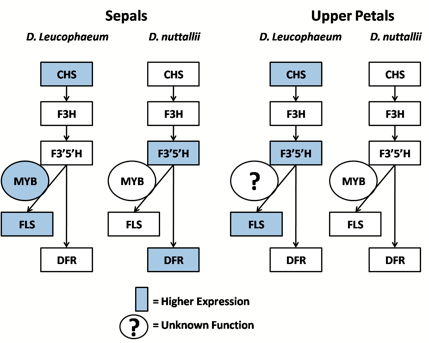
Figure 1. Enzymatic pathway summarizing floral gene expression differences discovered in D. leucophaeum and D. nuttallii.Boxes represent enzymes in the anthocyanin/flavonol biosynthetic pathway and circles represent regulatory genes. Shaded boxes indicate higher gene expression. MYB was a myb-type regulatory factor discovered in this experiment. It was determined to be a regulator of FLS in D. nuttallii but its expression was uncoupled from that of FLS in D. leucophaeum (at the position indicated by the circle with a question mark), providing a mechanism for differential regulation between species.
PHB Production in Latex-Producing Plants
Kassandra Gaya Reuss-Schmidt
(Advisor: Dalton)
Biodegradable plastics, such as polyhydroxybutyrate (PHB), offer a solution to the problem of persistent plastic waste. However, large-scale production remains an issue for the commercial viability of PHB. One way of achieving the necessary production capacity might be through the use of transgenic plants, which are thought have the potential of producing PHB on a ton per ton basis. This thesis explores the possibility of synthesizing the biodegradable plastic PHB in three latex-producing plant species, Euphobia pulcherima, Taraxacum koksaghyz, and Parthenium argentatum. Leaf disk transformations on T. koksaghyz and P. argentatum were attempted via Agrobacterium tumerfaciens strain 4404 containing the binary vector, pBI ABC, which has the genes necessary for the synthesis of PHB: phbA, phbB, and phbC. Euphobia pulcherima had been previously transformed with both the pBI ABC vector and pGUS-INT. Plants transformed with pGUS-INT, containing gus, were used as a control. The transformed calli of E. pulcherima were analyzed for transformation efficiency via PCR amplification and the % dry weight of PHB was determined via measurements from a gas chromatograph (GC). The GC results showed a significant difference between the experimental, transformed with pBI ABC, and control group. It appears the transformation of E. pulcherima was successful and ~0.35 % dry weight of calli was composed of PHB. (This study was funded in part by a grant from the Reed College Biology Undergraduate Research Program)
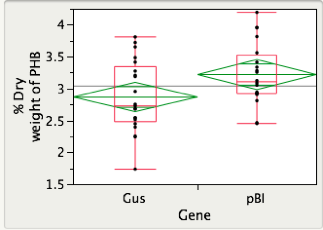
Figure: The mean % dry weight of PHB was compared using an ANOVA and pooled t-test, between E. pulcherrima transformed with A. tumefaciens strain 4404 containing pGUS-INT or pBI ABC, symbolized by Gus and pBI, respectively. The analysis was performed in JMP and the quartiles, showing the spread of the data by dividing it into 4 equal parts, and mean diamonds, whose central line indicates the mean while the two other a horizontal lines show the standard deviation, are displayed.
An in vivo Screen for Virulence Determinants of Enterotoxigenic Escherichia coli in Caenorhabditis elegans
Saate Saiyara Shakil
(Advisor: Mellies)
Enterotoxigenic Escherichia coli (ETEC), the leading cause of traveler's diarrhea, kills many hundreds of thousands of children in the developing world each year. Although efforts to increase vaccine efficacy against ETEC are under way, the group most at risk from ETEC disease has yet to benefit from any prophylactic treatments devised so far. While much information about ETEC's virulence mechanisms has been gained through study of the organism in vitro, outside a live host, a deeper understanding of the bacterium's interactions with the host environment could aid clinical efforts against the disease. The effort to gain knowledge of ETEC pathogenesis in vivo, and indeed the pathogenesis of many bacteria during infection, has been stymied by the search for a cost-effective model organism. The soil-dwelling nematode, Caenorhabditis elegans, has recently emerged as an easily propagated, genetically tractable host that has been shown to experience infection by pathogens in a similar manner to mammalian hosts. This thesis sought to increase the utility of the nematode model by screening a library of single-gene ETEC mutants for attenuated virulence in C. elegans. A library of transposon-insertion mutants was created using a fluorescently labeled strain of ETEC, and screened for decreased fluorescence in the nematode gut to identify mutants with transposon insertions in virulence genes. Although fluorescence could not be localized to the C. elegans intestinal lumen because of a high background signal, the scaling up of the system showed much promise in this thesis, and could conceivably be used to screen the entire ETEC genome. Further efforts to tune the system could lead to the development of a high-throughput method of identifying virulence factors expressed in vivo, which has never before been attempted for ETEC. (This study was funded in part by a grant from the Reed College Biology Undergraduate Research Program)
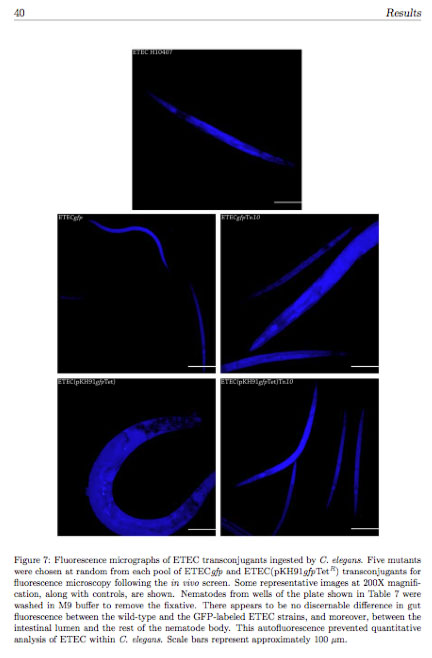
Silencing a killer: The conserved relationship between p53 and its main regulator, MDM2, in Xenopus laevis
Erin Christopher Smith
(Advisor: Ruben)
p53 is a dynamic protein that functions as the main regulator of cell death and has been well characterized in humans. This thesis attempts to better characterize its regulating role in the model organism Xenopus laevis, by directly studying protein expression levels of p53 and its main regulator, XDM2. Work here shows the successful recognition of XDM2 by an anti-Mdm2 antibody and the presence of XDM2 in the thymus but not in other tissues tested. Additionally, p53 levels in the thymus were found to slightly increase 6 hours after irradiation by UV (ultra-violet) but seemed to be lower in this tissue than other tissues tested. Lower levels of Xp53 and expression of XDM2 in the thymus suggest physiological differences from that of other organs in the apoptotic pathway in the thymus of Xenopus laevis. (This study was funded in part by a grant from the Reed College Biology Undergraduate Research Program)
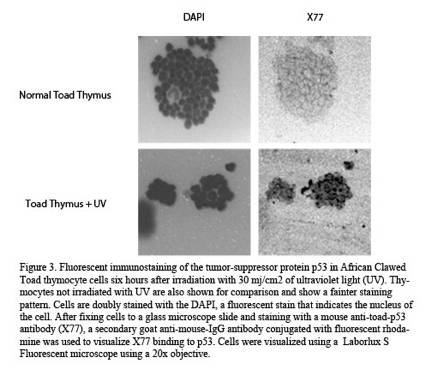
Expression of the Tumor Suppressor Protein p53 in Xenopus laevis Cell Lines
Hannah Kendall Smith
(Advisor: Ruben)
The p53 protein is a crucial mediator of cell-cycle arrest and apoptosis. Activated by genotoxic stress, it initiates one of two apoptotic pathways in response to severe DNA-damage. In the first, it serves as a transcription factor, binding the DNA and promoting the transcription of genes encoding pro-apoptotic proteins, while simultaneously suppressing the transcription of genes encoding anti-apoptotic proteins. The second pathway is transcription-independent, and involves p53 migrating to the cytoplasm and interacting directly in pro-apoptotic proteins to induce mitochondrial outer membrane permeabilization, which releases cell-death factors and triggers the apoptotic cascade. The p53 protein is often mutated in cancers, and the consequent lack of apoptotic function results in uncontrolled growth despite DNA damage. Due to differences in p53 activity between mammals and amphibians, tumors are very rare in frogs. This study looks at the accumulation of p53 in response to UV-irradiation in three rare cell lines derived from Xenopus laevis thymomas, the 15/0, B3B7, and ff-2 cell lines, in comparison the A6 immortalized Xenopus kidney cell line and normal Xenopus thymus cells. Although the results were inconclusive for the B3B7 and ff-2 cell lines, p53 was induced by UV-treatment in the 15/0 cell line; p53 also accumulated in response to UV-irradiation in the A6 cell line and normal thymus cells. (This study was funded in part by a grant from the Reed College Biology Undergraduate Research Program)

Figure: Percent inhibition relative to the no-inhibition control for 15/0, A6, and normal thymus UV-treated and control cell extracts. Cell extracts were incubated with anti-p53 antibody and then transferred to wells coated with p53 peptide. Any p53 in the cell extracts would bind to the antibody and remain in solution, inhibiting the antibody from binding to the peptide coating the well. The greater the inhibition, the more p53 in the cell extracts. This graph shows the average percent inhibition for the 15/0 thymoma cell line, the A6 immortalized kidney cell line, and normal thymus extracts, control and UV-treated. Error bars show one standard error and n=6. Differences were significant between the two 15/0 extracts (P=0.0044).
Challenged Moms: The Challenge Hypothesis in Female Astatoltilapia burtoni
Amanda Catherine Trail
(Advisor: Renn)
In vertebrate species where investment in parental care is important, the Challenge Hypothesis (Wingfield, 1990) predicts that androgen concentrations are maintained at sub-threshold levels and increase only in response to a territorial intrusion. However, the Challenge Hypothesis was first proposed in relationship to male birds, and while its assumptions have been tested in other species, it has rarely been applied to female teleost fish. The current study focuses on a territorial and maternal mouth-brooding cichlid fish, Astatotilapia burtoni, and seeks to answer three questions. First, will hormone concentrations differ between challenged and unchallenged maternal A. burtoni? Second, given that hormone concentrations have been shown to vary between mouth-brooding cichlids at different points throughout the reproductive cycle (Martin et. al 2004, Carleton 2009), will there be a response to challenge between two different time points? Finally, since maternal patterns of behavior vary between wild-stock and lab-stock A. burtoni (Renn 2009), will there be a different response to challenge between two different stocks of fish?
Behavioral data and blood samples were taken six days into the brooding cycle and one day post fry release from wild-stock and lab-stock females that were either presented with a conspecific intruder or were not challenged. Circulating testosterone levels were determined for plasma samples by running a testosterone ELISA. Results showed that wild-stock females attacked intruders more frequently upon fry-release than did lab-stock females. Also, while other maternal and aggressive behaviors did not vary significantly between challenged and non-challenged females, trends existed which indicate that upon challenge, wild-stock fish frequently displayed their dorsal fin and spent more time guarding the nest compared to lab-stock fish. Though there was no statistically significant hormonal response to challenge, females that released their fry had higher testosterone concentrations than brooding females. (This study was funded in part by a grant from the Reed College Biology Undergraduate Research Program)
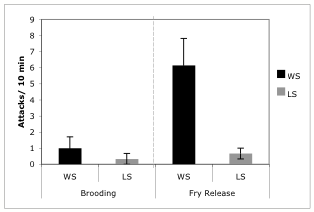
Figure 7. Average number of times WS and LS females attacked a conspecific intruder six days post-spawning and one day post-fry release during 10-minute focal observations.
Analysis of HIV-1 Assembly Inhibitors for Potential Antiretroviral Drugs
Seyram Michelle Tsagli
(Liaison Advisor: Russell)
HIV is a retrovirus that causes AIDS. It infects the cells of the immune system and impairs its function. The current treatment of HIV is through the use of antiviral drugs that suppress the virus. Although they cannot eliminate the virus from the body, they can delay progression to AIDS. These antiretroviral drugs currently being used target important viral enzymes such as reverse transcriptase, protease and integrase enzymes. They also target the entry and fusion steps of the viral replication cycle. However, the assembly process of the HIV-1 replication cycle and the structural proteins involved are potentially inhibitable targets. To investigate the possibility of interfering with the HIV replication cycle at assembly or other steps, peptides and compounds were screened to determine which ones might work as virus replication inhibitors. These compounds and peptides were selected either based on computational calculations to determine small molecules that might bind tightly to important capsid protein surface residues or based on the potential of competition during capsid oligomerization by peptides with amino acid sequences that mimic portions of the capsid protein. The hypothesis was that some of these compounds would prove to be effective non-toxic inhibitors of HIV replication in general or the assembly or release step. To determine the effect of the compounds on replication inside cells, plasmid DNAs were introduced into cells which were then treated with compounds and different cells with a green fluorescent protein tag were added. The cells were then viewed by fluorescence microscopy to determine the number of infectious virus particles produced. Results obtained indicated that about 30% of the compounds screened impaired virus replication. To investigate whether the assembly process was the target of the compounds, the capsid protein was incubated with the compounds and induced to assembly. Spectrophotometric and pelleting assay results showed an effect of the compounds on assembly which was confirmed by fluorescence and electron microscopy which showed altered morphologies of assembly products. Toxicity assays showed about 3 out of 20 compounds to be non-toxic to human cells to concentrations of up to 10 µM. Further studies to determine minimum effective concentrations of the compounds and to see if in vitro effects can be duplicated in vivo may help in the development of new antiretroviral drugs.



Figure 21. The effects of compounds 35616 (c and d) 329515 (e and f) 87221(g and h) 58931 (i and j) 58930 (k and l) and 134235(m and n) on the morphologies of capsid assembly products as compared to DMSO (a and b) as viewed by electron microscopy.
Capsid wild type protein [100µM in 50mM Tris pH7.0, NaCl 1M and 5mM BME] were assembled for 48 hours at 4°C in the presence of a) and b) DMSO at 5% final; c) and d) NCI 35616; e) and f) NCI 32951; g) and h) NCI 87221; i) and j) NCI 58931; k) and l) NCI 58930; m) and n) NCI 134235. The small compounds were dissolved in DMSO and the final concentration in the assays was 0.5mM. After the incubations, samples were processed for EM at low magnification (4800x) [images a, c, e, g, I, k, m] and high magnification (37000x) [images b, d, f, h, j, l, n]. Bar sizes included in a and b
Age- and Population-Specific Environmental Effects on the Phenotype of the Oriental Fire-Bellied Frog (Bombina orientalis): An Underdog Story
Erin Lynn Wilkus
(Advisor: Kaplan)
This thesis uses a common-garden design to evaluate the fitness consequences of environmentally induced morphology on the Oriental Fire-bellied Frog (Bombina orientalis) from the field in the Republic of Korea. This study additionally provides evidence for phenotypic divergence between two geographically distinct populations (Chun Cheon and Jung Bong). A coherent understanding of how environmentally induced morphology relates to divergence between populations was achieved by evaluating three fundamental questions concerning the effects of two well-studied environmental factors: thermal variance and maternal investment (i.e. egg size).
(1) How does thermal variance and maternal investment effect phenotype? High levels of thermal variance tended to decrease the total length of individuals and high levels of maternal investment tended to increase total body length at discrete time points in ontogeny. The effects of thermal variance and maternal investment were age specific.
(2) Are phenotypic traits that result from development in specific thermal environments or from specific levels of maternal investment adaptive? Swimming performance was directly effected by changes in thermal variance at the hatchling stage (day 5). At later stages in development thermal variance did not have direct effects on performance. Maternal investment did not have direct effects on performance at any of the points in development that were investigated. However, temperature variance and maternal investment both influenced swimming performance through their effects on morphology and the strength of these effects were age-specific.
(3) Is the pattern of phenotypic response across different environments itself subject to selection? The pattern of phenotypic response in the Chun Cheon and Jung Bong populations differed across levels of thermal variance and maternal investment late in development (day 22). Compensatory growth associated with high levels of thermal variance only occurred in the Chun Cheon population, whereas compensatory growth associated with low levels of maternal investment only occurred in the Jung Bong population. Additionally, only the Chun Cheon population allocated resources to increase tail length growth rates, a morphological trait that is positively associated with fitness surrogates. This suggests that population variation in the shape of growth trajectories and the relationship between growth trajectories across different levels of temperature variance and maternal investment may be subject to and therefore a result of natural selection.
Gene expression profiles of female aggression in the Julidochromis
Kelsey Jordon Wood
(Advisor: Renn)
Differences between male and female behavior can be explained by differences in genetic makeup, sex hormones, and sexually dimorphic neuroanatomy. For many animals, the expression of sex-typical behavior is somewhat plastic and depends on the social environment. I use the African Julidochromis cichlid fish as a model system to determine the underlying physiological and molecular mechanisms that account for both differences in and plasticity of sex-typical behavioral phenotypes.
Julidochromis is a genus of monogamous, bi-parental cichlids that show territorial and parental sex-typical behavioral roles. They are unique among bi-parental cichlids because, in some Julidochromis species, the female is larger than her mate and provides the majority of territory defense for the pair. This reversal in behavior appears to be dependent on relative mate size, as experimental reversal of size ratios causes a sex-reversal in territorial behavior. Thus, sex-roles in Julidochromis appear to be plastic and contingent on the social context of relative mate size.
To examine the molecular changes that accompany this plastic change in sex- typical behavior, I used microarrays to compare the gene expression profiles of Julidochromis transcriptus males and females in two different social contexts (female-larger vs. male-larger pairs) in which they would show different patterns of territorial aggression. Aggressive females (female-larger pairs) and aggressive males (male-larger pairs) were found to have very different gene expression profiles, but there was a core set of genes whose expression level correlated with aggressive behavior in both sexes. This core set of similarly expressed genes may represent the genes whose expression is essential for aggressive behavior regardless of sex in J. transcriptus, while the genes that showed different expression patterns in males and females may represent sex-specific mechanisms for aggression.
I also compared the gene expression profiles for J. transcriptus female-larger pairs to an expression dataset from female-larger pairs of a closely related species, J. marlieri, to see if the molecular basis for sex-roles was conserved or diverged between the species. There was a set of genes expressed similarly in aggressive females of both species, and this was distinct from those expressed in aggressive males. The majority of genes showed species-specific variation in expression patterns, suggesting that Julidochromis species have undergone changes in gene expression patterns on an evolutionary time scale. (This study was funded in part by a grant from the Reed College Biology Undergraduate Research Program)
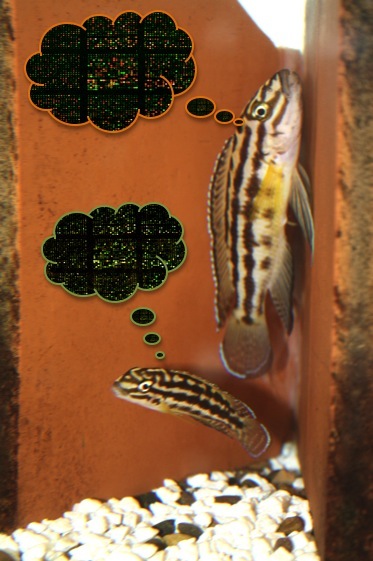
Figure: a monogamous J. marlieri pair in their ceramic nest. Thought bubbles represent brain gene expression profiles as generated by microarrays. The larger fish of this pair, the female, displays aggressive behavior against territory intruders while her mate does not. Aggressive females were shown to have distinct brain gene expression profile from aggressive males in this thesis.